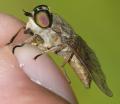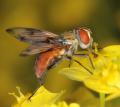Diptera.info :: Identification queries :: Diptera (adults)
Who is here? 1 guest(s)
|
Am I a fly?
|
|
| john browning |
Posted on 06-02-2005 11:01
|
|
Member Location: Posts: 9 Joined: 02.02.05 |
This little fellow (about 2mm) has what looks like a tiny second pair of wings instead of halteres. Is he really a member of the diptera tribe? The forked vein suggests Ceratopogodae. If he is a midge, he is of the non-biting sort. Can anyone help with identification? John 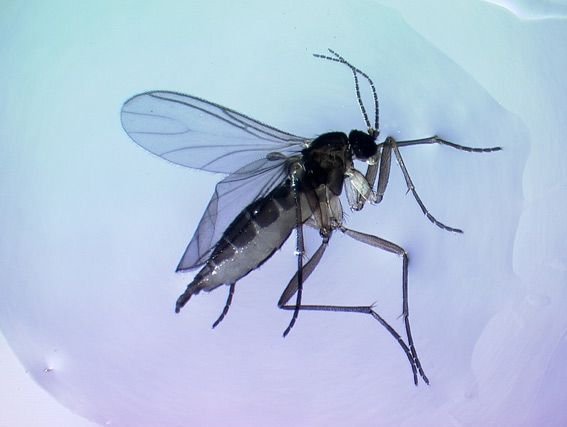 |
|
|
|
| Paul Beuk |
Posted on 06-02-2005 11:07
|
|
Super Administrator Location: Netherlands Posts: 19403 Joined: 11.05.04 |
Hello John, This is a dark-winged fungus gnat, or Sciaridae. Larvae develop on fungi and mycelium and several species may be harmful as such. You can also find them indoors when they breed in flower pots which are humid and where mould is developing. Even when we do not notice it ourselves, they do.  BTW: John, did you get my reply to tour email? Paul - - - - Paul Beuk on https://diptera.info |
| john browning |
Posted on 06-02-2005 19:57
|
|
Member Location: Posts: 9 Joined: 02.02.05 |
Thanks Paul. Yes, I did get your e-mail. Halteres/tiny wings? And now...the Genus? John B |
|
|
|
| Paul Beuk |
Posted on 06-02-2005 20:42
|
|
Super Administrator Location: Netherlands Posts: 19403 Joined: 11.05.04 |
The halters are in fact modfied hind wings and as far as we know play a role during flight, but as you can imagine not for lift.  It mainly has to do with balance. There are mutants in Drosophila where the halters truely develop a wings. It mainly has to do with balance. There are mutants in Drosophila where the halters truely develop a wings.It will not be possible to identify you gnat to genus from this picture alone. There are several truely small details that determine which genus you're dealing with, e.g., the number of palpal segments, the presence/absence of a comb of setae on the tip of the fore tibia and the placement of small setae in that area. If you can provide details, well, we may have a chance. 
Paul - - - - Paul Beuk on https://diptera.info |
| kaiheller |
Posted on 07-02-2005 19:27
|
|
Member Location: Heikendorf, Germany Posts: 10 Joined: 07.02.05 |
Hello, Paul is right, without the the details he mentions a secure identification is not possible. But probability and some experience tell me that is a species of Bradysia. If it is caputured inhouse and at this season (winter in the northern hemisphere) , it is possibly the common house sciarid Bradysia tilicola [formerly B. amoena]. The males a much easier to rcognize by their characteristic gonostyles. So if there were a photo of a male as well, I could probably tell you the species an surely the genus. Good luck, Kai |
|
|
|
| john browning |
Posted on 08-02-2005 21:25
|
|
Member Location: Posts: 9 Joined: 02.02.05 |
Thanks Paul Here are some small details which might help - (jpeg attached, more to follow). Re. halteres - this is why I asked my first question. The structures on this fly look much more like small wings than the usual sticks-with-knobs. Is this a halfway development? Kai. Yes. Inside (in great numbers) in S.England in winter. Haven't found any males yet but will keep looking. John B 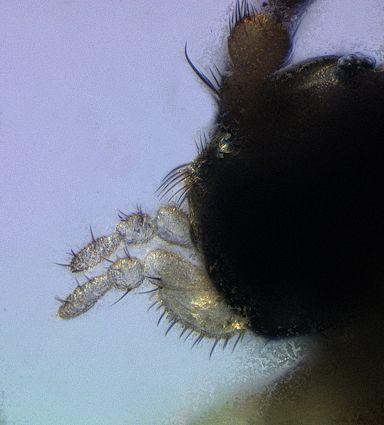 |
|
|
|
| john browning |
Posted on 08-02-2005 21:27
|
|
Member Location: Posts: 9 Joined: 02.02.05 |
Tip of the fore tibia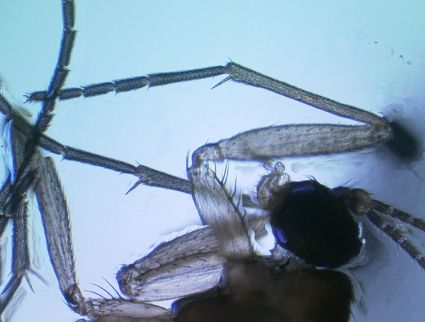 |
|
|
|
| john browning |
Posted on 08-02-2005 22:05
|
|
Member Location: Posts: 9 Joined: 02.02.05 |
A try at the head. Immersed in oil so not so clear but may be helpful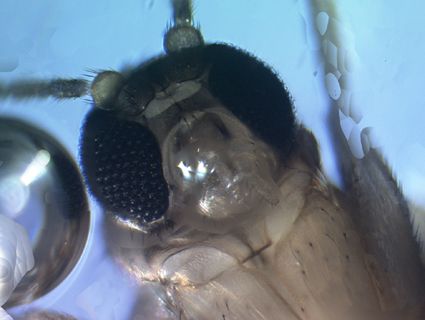 |
|
|
|
| kaiheller |
Posted on 08-02-2005 22:18
|
|
Member Location: Heikendorf, Germany Posts: 10 Joined: 07.02.05 |
John, concerning the the palpi it is definitely not the species, I supposed, because there should then be a clear sensory spot on the first segment. Seeing the male, really would be very interesting from the ecological and faunistic point of view. If you should find some, you might even send them to me. I am just getting all faunistic sciarid data from Great Britain into my database. |
|
|
|
| john browning |
Posted on 13-02-2005 20:32
|
|
Member Location: Posts: 9 Joined: 02.02.05 |
Kai still looking for a male. When I find one, I'll try to get the gonostyle details and, if posible send you sample(s) Paul are you able to tell anything from my last pics? John B |
|
|
|
| Paul Beuk |
Posted on 13-02-2005 21:00
|
|
Super Administrator Location: Netherlands Posts: 19403 Joined: 11.05.04 |
I think Kai is a much better expert then I am. 
Paul - - - - Paul Beuk on https://diptera.info |
| kaiheller |
Posted on 19-02-2005 11:36
|
|
Member Location: Heikendorf, Germany Posts: 10 Joined: 07.02.05 |
John, as there are no comprehensive keys, it is really difficult to rcognize female specimen, but still more difficult to do this from photos. No species I have in mind, really matches. Perhaps you could take one more photo of the front tibial end with higher magnification to see the details of the tibial patch or comb. So I can possibly tell you the genus. But perhaps it makes more sense to simply wait for a male.  Kai |
|
|
|
| john browning |
Posted on 23-02-2005 19:18
|
|
Member Location: Posts: 9 Joined: 02.02.05 |
Kai the search for a male continues ! here is a high mag photo of the fore tibia. Does it help? John B 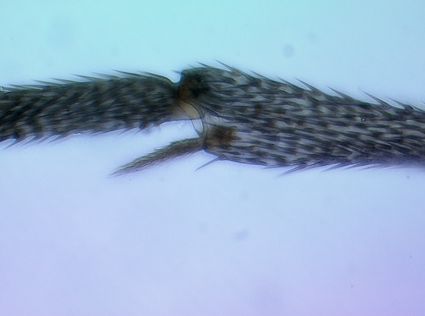 |
|
|
|
| kaiheller |
Posted on 26-02-2005 12:34
|
|
Member Location: Heikendorf, Germany Posts: 10 Joined: 07.02.05 |
Hello John, it seems to be the genus Bradysia, although te tibial comb is not quite clear. Kai |
|
|
|
| john browning |
Posted on 03-03-2005 22:15
|
|
Member Location: Posts: 9 Joined: 02.02.05 |
Kai Looking at many samples, I cannot see any comb or bristles at the tip of the fore tibia. There just don't seem to be any at all. Am I looking in the right place. The search for a male continues ! John B |
|
|
|
| Jump to Forum: |









